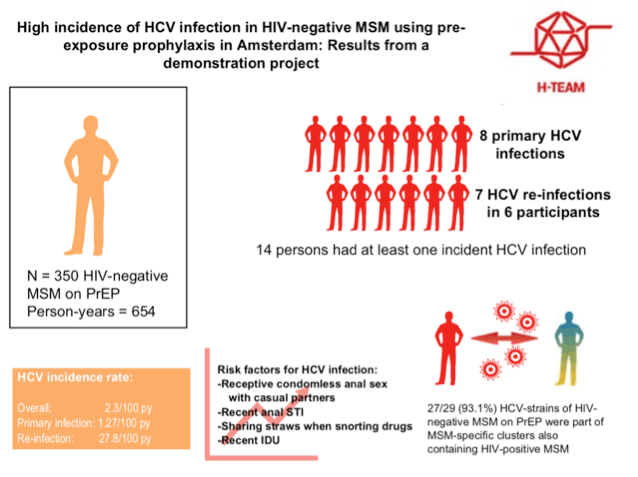| |
High incidence of HCV in HIV-negative men who have sex with men using pre-exposure prophylaxis
|
| |
| |
Download the PDF here
Lay summary
We report that hepatitis C virus infections are frequently acquired among HIV-negative men who have sex with men (MSM) using pre-exposure prophylaxis to prevent HIV infection. New infections occurred more frequently in those reporting receptive anal sex without using condoms, having an anal sexually transmitted infection, injecting drugs, and sharing straws when snorting drugs. The viruses found in HIV-negative men using pre-exposure prophylaxis are genetically similar to those in HIV-positive men, but not in other hepatitis C risk groups, suggesting that (sexual) transmission is occurring between HIV-positive MSM and HIV-negative MSM using pre-exposure prophylaxis.
Among HIV-negative MSM enrolled in the Amsterdam PrEP project, we found a high incidence of HCV primary and re-infection, with a much lower IR for primary than re-infection. Factors associated with HCV infection were receptive CAS with casual partners, being diagnosed with an anal STI, IDU and sharing straws when snorting drugs. Phylogenetic analyses revealed that HCV sequences of HIV-negative MSM starting or using PrEP were highly interspersed with HCV sequences from HIV-positive MSM.
Jnl of Hepatology Dec 2019 - Elske Hoornenborg1,*, Liza Coyer1, Anders Boyd1,5, Roel Christiaan Alfons Achterbergh1, Maarten Franciscus Schim van der Loeff1,2, Sylvia Bruisten1, Henry John Christiaan de Vries1,3, Jelle Koopsen4, Thijs J.W. van de Laar6,7, Maria Prins1,2, on behalf of the Amsterdam PrEP Project team in the HIV Transmission Elimination AMsterdam (H-TEAM) Initiative

Highlights
• HIV-negative men who have sex with men while on pre-exposure prophylaxis are at risk of incident HCV infection.
• High incidence rates of both HCV primary and re-infection were observed.
• Identified HCV risk-factors were similar to those in HIV-positive men who have sex with men.
• Specific clusters of HCV strains were identified in men who have sex with men, with and without HIV.
• HCV-testing for HIV-negative men who have sex with men while on pre-exposure prophylaxis is recommended.
Background & Aims
HCV has emerged as a sexually transmitted infection (STI) among HIV-positive men who have sex with men (MSM). We evaluated HCV incidence and its risk factors among HIV-negative MSM using HIV pre-exposure prophylaxis (PrEP).
Methods
Participants of the Amsterdam PrEP project were tested for HCV antibodies or HCV-RNA every 6 months. Participants used daily or event-driven PrEP and could switch regimens during follow-up. We calculated incidence rates (IRs) for overall HCV infection and separately for primary and re-infection. A univariable Bayesian exponential survival model was used to identify risk factors associated with incident HCV infection. The HCV NS5B gene fragment (709 bp) was sequenced and compared to HCV isolates from HIV-positive MSM and other risk groups (n = 419) using phylogenetic analysis.
Results
Among 350 participants contributing 653.6 person-years (PYs), we detected 15 HCV infections in 14 participants (IR = 2.30/100PY). There were 8 primary infections (IR = 1.27/100PY) and 7 re-infections (IR = 27.8/100PY). IR was 2.71/100PY in daily and 1.15/100PY in event-driven PrEP users. Factors associated with incident HCV infection were higher number of receptive condomless anal sex acts with casual partners (posterior hazard ratio [HR] 1.57 per ln increase; 95% credibility interval [CrI] 1.09–2.20), anal STI (posterior HR 2.93; 95% CrI 1.24–7.13), injecting drug use (posterior HR 4.69; 95% CrI 1.61–12.09) and sharing straws when snorting drugs (posterior HR 2.62; 95% CrI 1.09–6.02). We identified robust MSM-specific HCV clusters of subtypes 1a, 4d, 2b and 3a, which included MSM with and without HIV.
Conclusions
HIV-negative MSM using PrEP are at risk of incident HCV infection, while identified risk factors are similar to those in HIV-positive MSM. Regular HCV testing is needed, especially for those with a previous HCV infection and those reporting risk factors.
|
|
| |
| |
|
|
|